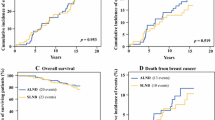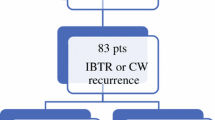Abstract
Whether an axillary lymph node dissection (ALND) is needed for breast cancer patients with minimal sentinel lymph node (SLN) involvement is arguable despite recent data supporting the omission of axillary clearance in these patients. Data on disease recurrence of 111 patients with SLN involvement and no ALND were analysed. Patients with minimal SLN involvement were assessed for their risk of non-SLN metastasis by means of several nomograms. The series included patients with isolated tumour cells (n = 76), micrmetastasis (n = 33) and macrometastasis (n = 2) who were followed for a median of 37 months (range 12–148 months). Six patients died, 3 of disease and 3 of unrelated causes. Eight further patients had breast cancer related events: 1 local breast recurrence and seven distant metastases. No axillary regional recurrence was detected. Disease related events were not associated with the risk of non-SLN metastasis. The presented data suggest that omitting ALND in patients with low volume SLN metastasis may be a safe procedure, and support the observation that systemic disease recurrence may not be associated with axillary recurrence or the risk of NSLN involvement predicted by nomograms.

Similar content being viewed by others
References
Veronesi U, Viale G, Paganelli G, Zurrida S, Luini A, Galimberti V et al (2010) Sentinel lymph node biopsy in breast cancer: ten-year results of a randomized controlled study. Ann Surg 251:595–600
Zavagno G, De Salvo GL, Scalco G, Bozza F, Barutta L, Del Bianco P et al (2008) A randomized clinical trial on sentinel lymph node biopsy versus axillary lymph node dissection in breast cancer: results of the Sentinella/GIVOM Trial. Ann Surg 247:207–213
Andersson Y, de Boniface J, Jönsson PE, Ingvar C, Liljegren G, Bergkvist L et al (2012) Axillary recurrence rate 5 years after negative sentinel node biopsy for breast cancer. Br J Surg 99:226–231
Hunt KK, Ballman KV, McCall LM, Boughey JC, Mittendorf EA, Cox CE et al (2012) Factors associated with local-regional recurrence after a negative sentinel node dissection: results of the ACOSOG Z0010 trial. Ann Surg 256:428–436
Krag DN, Anderson SJ, Julian TB, Brown AM, Harlow SP, Costantino JP et al (2010) Sentinel-lymph-node resection compared with conventional axillary-lymph-node dissection in clinically node-negative patients with breast cancer: overall survival findings from the NSABP B-32 randomised phase 3 trial. Lancet Oncol 11:927–933
Cserni G, Burzykowski T, Vinh-Hung V, Kocsis L, Boross G, Sinko M et al (2004) Axillary sentinel node and tumour-related factors associated with non-sentinel node involvement in breast cancer. Jpn J Clin Oncol 34:519–524
Viale G, Maiorano E, Pruneri G, Mastropasqua MG, Valentini S, Galimberti V et al (2005) Predicting the risk for additional axillary metastases in patients with breast carcinoma and positive sentinel lymph node biopsy. Ann Surg 241:319–325
Giuliano AE, McCall L, Beitsch P, Whitworth PW, Blumencranz P, Leitch AM et al (2010) Locoregional recurrence after sentinel lymph node dissection with or without axillary dissection in patients with sentinel lymph node metastases: the American College of Surgeons Oncology Group Z0011 randomized trial. Ann Surg 252:426–432
Solá M, Alberro JA, Fraile M, Santesteban P, Ramos M, Fabregas R et al (2013) Complete axillary lymph node dissection versus clinical follow-up in breast cancer patients with sentinel node micrometastasis: final results from the multicenter clinical trial AATRM 048/13/2000. Ann Surg Oncol 20:120–127
Galimberti V, Cole BF, Zurrida S, Viale G, Luini A, Veronesi P et al (2013) Axillary dissection versus no axillary dissection in patients with sentinel-node micrometastases (IBCSG 23-01): a phase 3 randomised controlled trial. Lancet Oncol 14:297–305
Park J, Fey JV, Naik AM, Borgen PI, Van Zee KJ, Cody HS 3rd (2007) A declining rate of completion axillary dissection in sentinel lymph node-positive breast cancer patients is associated with the use of a multivariate nomogram. Ann Surg 245:462–468
Bilimoria KY, Bentrem DJ, Hansen NM, Bethke KP, Rademaker AW, Ko CY et al (2009) Comparison of sentinel lymph node biopsy alone and completion axillary lymph node dissection for node-positive breast cancer. J Clin Oncol 27:2946–2953
Wasif N, Maggard MA, Ko CY, Giuliano AE (2010) Underuse of axillary dissection for the management of sentinel node micrometastases in breast cancer. Arch Surg 145:161–166
Goldhirsch A, Wood WC, Coates AS, Gelber RD, Thürlimann B, Senn HJ et al (2011) Strategies for subtypes-dealing with the diversity of breast cancer: highlights of the St. Gallen International expert consensus on the primary therapy of early breast cancer 2011. Ann Oncol 22:1736–1747
AGO, DGS, SGS, ÖGS, Panelists, Executive Board Members (2013) German, Austrian and Swiss consensus conference on the diagnosis and local treatment of the axilla in breast cancer. Eur J Cancer 49:2277–2283
Tvedskov TF, Jensen MB, Lisse IM, Ejlertsen B, Balslev E, Kroman N (2012) High risk of non-sentinel node metastases in a group of breast cancer patients with micrometastases in the sentinel node. Int J Cancer 131:2367–2375
Meretoja TJ, Strien L, Heikkilä PS, Leidenius MH (2012) A simple nomogram to evaluate the risk of nonsentinel node metastases in breast cancer patients with minimal sentinel node involvement. Ann Surg Oncol 19:567–576
Houvenaeghel G, Nos C, Giard S, Mignotte H, Esterni B, Jacquemier J et al (2009) A nomogram predictive of non-sentinel lymph node involvement in breast cancer patients with a sentinel lymph node micrometastasis. Eur J Surg Oncol 35:690–695
Houvenaeghel G, Bannier M, Nos C, Giard S, Mignotte H, Jacquemier J et al (2012) Non sentinel node involvement prediction for sentinel node micrometastases in breast cancer: nomogram validation and comparison with other models. Breast 21:204–209
Grabau D, Dihge L, Ferno M, Ingvar C, Ryden L (2013) Completion axillary dissection can safely be omitted in screen detected breast cancer patients with micrometastases. A decade’s experience from a single institution. EJSO 39:601–607
Cserni G, Rajtár M, Boross G, Sinkó M, Svébis M, Baltás B (2002) Comparison of vital dye-guided lymphatic mapping and dye plus gamma probe-guided sentinel node biopsy in breast cancer. World J Surg 26:592–597
Cserni G (2001) The potential value of intraoperative imprint cytology of axillary sentinel lymph nodes in breast cancer patients. Am Surg 67:86–91
Cserni G (2002) Complete step sectioning of axillary sentinel lymph nodes in patients with breast cancer. Analysis of two different step sectioning and immunohistochemistry protocols in 246 patients. J Clin Pathol 55:926–931
Cserni G, Bezsenyi I, Marko L (2013) Patients′ choice on axillary lymph node dissection following sentinel lymph node micrometastasis–first report on prospective use of a nomogram in very low risk patients. Pathol Oncol Res 19:211–216
Cserni G, Gregori D, Merletti F, Sapino A, Mano MP, Ponti A et al (2004) Meta-analysis of non-sentinel node metastases associated with micrometastatic sentinel nodes in breast cancer. Br J Surg 91:1245–1252
van Deurzen CH, de Boer M, Monninkhof EM, Bult P, van der Wall E, Tjan-Heijnen VC et al (2008) Non-sentinel lymph node metastases associated with isolated breast cancer cells in the sentinel node. J Natl Cancer Inst 100:1574–1580
De Mascarel I, MacGrogan G, Debled M, Brouste V, Mauriac L (2008) Distinction between isolated tumor cells and micrometastases in breast cancer: is it reliable and useful? Cancer 112:1672–1678
Cserni G, Bianchi S, Vezzosi V, van Diest P, van Deurzen C, Sejben I et al (2008) Variations in sentinel node isolated tumour cells / micrometastasis and non-sentinel node involvement rates according to different interpretations of the TNM definitions. Eur J Cancer 44:2185–2191
Meretoja TJ, Vironen JH, Heikkila PS, Leidenius MH (2010) Outcome of selected breast cancer patients with micrometastasis or isolated tumor cells in sentinel node biopsy and no completion axillary lymph node dissection. J Surg Oncol 102:215–219
Acknowledgments
The authors acknowledge the general support of Drs József Pap-Szekeres and Gábor Pajkos, heads of the Departments of Surgery and Oncology at the Bács-Kiskun County Teaching Hospital, respectively. The help of Gábor Fejes, Department of Informatics is also kindly acknowledged.
Conflict of Interest
The authors have no conflict of interest to report.
Author information
Authors and Affiliations
Corresponding author
Rights and permissions
About this article
Cite this article
Cserni, G., Maráz, R. Regional Disease Control in Selected Patients with Sentinel Lymph Node Involvement and Omission of Axillary Lymph Node Dissection. Pathol. Oncol. Res. 21, 861–866 (2015). https://doi.org/10.1007/s12253-015-9899-6
Received:
Accepted:
Published:
Issue Date:
DOI: https://doi.org/10.1007/s12253-015-9899-6




